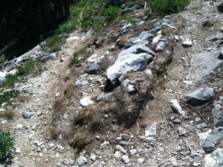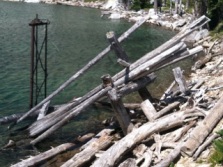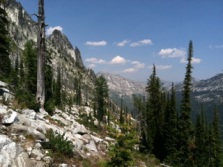You are currently browsing the category archive for the ‘Forest Service’ category.
By Brett Haverstick

Taking a long trip into the backcountry during winter doesn’t appeal to some people. That’s understandable. But I enjoy it, and it’s something I try to do a few times a year. Winter backpacking is very different, and more challenging, compared to strapping on the pack during other seasons.
For one it’s darn cold, with many trips never getting above freezing, day or night. Two, there’s usually lots of snow on the ground, which means you’re probably wearing snowshoes, and, perhaps, breaking trail too. Three, your pack is heavier because of all the extra warm gear you are carrying, including more food because you need to consume a lot of calories each day. Four, you have to work harder in just about everything you do, from setting up your shelter and trying to stay warm to melting water and attempting to stay hydrated. Five, there’s not a lot of daylight, so you have to stay motivated and keep moving if you want to cover some miles. Lastly, not too many people want to spend 5-6 days in the cold, blowing snow of the northern Rockies in January! But find someone to share the workload if you can!
My recent trip into the Frank Church-River of No Return Wilderness was with a friend, and, perhaps more importantly, an individual with a skill set that I could trust and depend on. Once the weather report showed a high-pressure system moving across the region, Russell and I finalized our plans and set out for the trailhead. We felt confident we could cover 50 miles before the next weather front moved in.
For two and a half days, we trudged across the frozen ridge, one foot after the other, breaking snow almost the entire time. Occasionally, we would hear the call of the raven or the knock of the woodpecker, but for the most part we walked in silence and deep in thought. Accompanying us the whole time was a set of moose tracks, with deer and elk tracks scattered about. It appeared snowshoe hare were in the area too. Blood on the trail indicated that a mountain lion, or another carnivore, might have wounded one of the ungulates.
The daily routine of building the morning fire, boiling water, drying gear, packing up, snowshoeing 10-16 miles, and then searching for a place to dig out the next snow cave was in some ways more mentally challenging than physical. But the white silence of the forest was peaceful, views of the snow-covered mountain peaks were tantalizing, and the cold, crisp air was exhilarating. With each arduous step, the wilderness boundary drew nearer.
You know the feeling. As one travels down the trail, through the forest, around the next bend or over the saddle, your heart pounds like a kid at Christmas. You anxiously await the sign that reads “…Wilderness, “…National Forest.” Yes, you say to yourself. Hope for humanity. Escape from the madness. Refuge for the plants and animals. Nature’s Bill of Rights at last. Leave me here and let me die with my true friends! And down the trail you continue.
Prior to our trip departure, Russell and I learned about the intent of the Idaho Fish & Game Department to land helicopters, and harass and collar elk, in the Frank Church-River of No Return Wilderness. We were angry, concerned, disappointed, and flabbergasted by the fact that the Forest Service gave the green light to land machines in the Wilderness, up to 120 times over a 3-month period. Of course, it doesn’t matter if it’s 1 time or 12 times, but 120 times was mind-blowing. Who the hell is running the Forest Service? Didn’t they, along with millions of Americans, just celebrate the 50th Anniversary of the Wilderness Act not too long ago? Looks like that was lip service!
And what about the people running the Idaho Fish & Game Department? Why do they still have authority over wildlife management on federal public lands? Why are their intensive and intrusive management plans being permitted in federally designated Wilderness? When is that going to change? Why is the Forest Service continually shining the shoes of the state hook and bullet departments? Who is really administering the Wilderness?
As Russell and I descended in elevation on the third day, the sun shined warmly, the skies stretched a bright blue, and the mighty Salmon River came within view. We peered though the binoculars, and combed the south-facing slopes for herds of elk. Dozens of ungulates lay basking on the hills, while those closer leaped and bound to a more secure place. We also observed whitetail and mule deer (strangely enough together) and lots of wolf tracks. Far off in the distance, we saw what looked like two golden eagles circling a spot on the hill, as if a kill had recently occurred.
Despite seeing a number of horses by the river late that afternoon (why are horses running freely on the national forest in winter, particularly in crucial winter-range habitat?), not a human was in sight, and the frozen riverbank was ours to explore and make home. We rested and dreamily watched small pieces of ice float downstream along the sides of the quiet, rolling river.
Later that evening, after a hot meal, warm fire, and the usual time-to-get hydrated routine, we dozed peacefully under a star-studded sky when suddenly we were awoken by the yips, screams, and howls of coyotes. After shaking our heads no, those are not wolves, we gleefully listened to the songs (and celebrations?) of a dozen coyotes not far from our tarp. They yipped for 3-4 minutes but it felt like a lot longer than that. The sweet music of the Wilderness had finally reached us!
When day broke and our bags were packed, Russell and I contemplated where the Idaho Fish & Game helicopters could be. Were they invading to the south along Big Creek? Were they harassing and stressing dozens of cows and calves to the east? The mere thought of these non-conforming, highly mechanized machines flying and landing wherever they want in the Wilderness made us sick to our stomachs. We both wanted to know how can the uses of helicopters, net-guns, tranquilizers, and GPS-collars be the minimal tool(s) needed to administer the Frank Church-River of No Return Wilderness? None of it made any sense. Little did we know that wolves were being collared too.
Which leads me to my final thoughts. What good is a National Wilderness Preservation System if the federal officials charged with administering the system, and individual areas, continues to approve projects that are incompatible with the Wilderness Act? Why are the Forest Service, Bureau of Land Management, National Park Service, and U.S. Fish and Wildlife Service repeatedly rubber-stamping proposals that harm Wilderness? How is the collaring of wildlife in federally designated wilderness representative of a self-willed landscape? Explain to me how helicopters, net-guns, and radio-collars enhance or preserve wilderness character?
This tragedy (“accident”) should serve as a lightning rod to spark a discussion, better yet, a movement, to do two things: create an independent federal department solely charged with stewardship of the wilderness system, and pressure Congress to pass legislation that forbids all state fish and game agencies from conducting any operations inside federally designated Wilderness.
To hell with the Forest Service and the other federal agencies, which continue to trammel the Wilderness and our natural heritage. We cannot keep leaving it to the attorneys to defend the Wilderness Act. We must do something bold. The status quo is badly broken and only getting worse. Ed Abbey is rolling in his grave and still screaming, “The Idea of wilderness needs no defense, just defenders.” This message needs to reach every living room in America.
Brett Haverstick is the Education & Outreach Director for Friends of the Clearwater, a public lands advocacy group based in Moscow, Idaho. He has a B.S. in Parks & Recreation Management from Northern Arizona University and a Master’s degree in Natural Resources from the University of Idaho. He has been a member of Wilderness Watch since 2007. The views expressed are his own.
 Of Wolves and Wilderness
Of Wolves and Wilderness
By George Nickas
“One of the most insidious invasions of wilderness is via predator control.” – Aldo Leopold, A Sand County Almanac
Right before the holidays last December, an anonymous caller alerted Wilderness Watch that the Forest Service (FS) had approved the use of one of its cabins deep in the Frank Church-River of No Return Wilderness (FC-RONRW) as a base camp for an Idaho Department of Fish and Game (IDFG) hunter-trapper. The cabin would support the hired trapper’s effort to exterminate two entire wolf packs in the Wilderness. The wolves, known as the Golden Creek and Monumental Creek packs, were targeted at the behest of commercial outfitters and recreational hunters who think the wolves are eating too many of “their” elk.
Idaho’s antipathy toward wolves and Wilderness comes as no surprise to anyone who has worked to protect either in Idaho. But the Forest Service’s support and encouragement for the State’s deplorable actions were particularly disappointing. Mind you, these are the same Forest Service Region 4 officials who, only a year or two ago, approved IDFG’s request to land helicopters in this same Wilderness to capture and collar every wolf pack, using the justification that understanding the natural behavior of the wolf population was essential to protecting them and preserving the area’s wilderness character. Now, somehow, exterminating those same wolves is apparently also critical to preserving the area’s wilderness character. The only consistency here is the FS and IDFG have teamed up to do everything possible to destroy the Wilderness and wildlife they are required to protect.

Middle Fork Salmon River, Frank Church-River of No Return Wilderness, Idaho: Where nine wolves were killed by IDFG’s hired hunter-trapper. Photo: Rex Parker
Wilderness Watch, along with Defenders of Wildlife, Western Watersheds Project, Center for Biological Diversity, and Idaho wildlife advocate Ralph Maughan, filed suit in federal court against the Forest Service and IDFG to stop the wolf slaughter. Our suit alleges the FS failed to follow its own required procedures before authorizing IDFG’s hunter-trapper to use a FS cabin as a base for his wolf extermination efforts, and that the program violates the agency’s responsibility under the 1964 Wilderness Act to preserve the area’s wilderness character, of which the wolves are an integral part. Trying to limit the number of wolves in Wilderness makes no more sense than limiting the number of ponderosa pine, huckleberry bushes, rocks, or rainfall. An untrammeled Wilderness will set its own balance.
The FS’s anemic defense is that it didn’t authorize the killing, therefore there is no reviewable decision for the court to overturn, and that it was still discussing the program with IDFG (while the trapper was in the field killing the wolves). Unfortunately, the district judge sided with the FS and IDFG, so we filed an appeal with the Court of Appeals for the Ninth Circuit. Rather than defend its action before the higher court, Idaho informed the court that it was pulling the trapper out of the Wilderness and would cease the program for this year. In the meantime, nine wolves are needlessly dead.
We will continue to pursue our challenge because the killing program will undoubtedly return. The Forest Service can’t and shouldn’t hide behind the old canard that “the states manage wildlife.” Congress has charged the FS with preserving the area’s wilderness character and the Supreme Court has held many times that the agency has the authority to interject itself in wildlife management programs to preserve the people’s interest in these lands. Turning a blind-eye is a shameful response for an agency that used to claim the leadership mantle in wilderness stewardship.
Wilderness Watch expresses its deep appreciation to Tim Preso and his colleagues at Earthjustice for waging a stellar legal battle on our behalf and in defense of these wilderness wolves.
George Nickas is the executive director of Wilderness Watch. George joined Wilderness Watch as our policy coordinator in 1996. Prior to Wilderness Watch, George served 11 years as a natural resource specialist and assistant coordinator for the Utah Wilderness Association. George is regularly invited to make presentations at national wilderness conferences, agency training sessions, and other gatherings where wilderness protection is discussed.
By Jerome Walker and Marcia Williams
After reading “A Dam Dilemma” in the Missoula Independent in mid-July, we decided to hike up to the Fred Burr Dam in the Selway-Bitterroot Wilderness in Montana to see what all the fuss was about. One of us is 74 years old and the other is from New York, had only camped once and had never backpacked, but we were powerfully curious.
The first night we packed in to a campsite 7.5 miles up Fred Burr Creek. That day we saw two other backpackers, but the next two days we saw no human being and enjoyed the quiet found only in Wilderness. By lunchtime of the second day we were at the dam.
We noticed straight off that the partly collapsed catwalk that the private company, Fred Burr High Lake Inc., wants to repair by using a helicopter to bring in 682 pounds of boards, etc., was constructed from on-site trees, not from sawn lumber. The dam itself, which doesn’t need repairs, was also constructed from on-site material. We wondered why the catwalk couldn’t just be repaired using local materials again, as there were plenty of trees and deadfall around. There was a spillway to take care of any overflow, so a federal judge’s recent assertion that “leaving Fred Burr Dam unrepaired could do more damage to the Wilderness than a single helicopter” didn’t make much sense either. (Federal Judge Donald Molloy recently ruled the Forest Service could authorize the private company to use a helicopter to transport materials for this minor repair to the dam.)
Hiking up to the dam we crawled over or ducked under some deadfall, but these need only to be cut with crosscut saws as a matter of routine trail maintenance for both horses and people to pass easily. At no point did we see switchbacks that would have been impossible for horses to negotiate, as the Forest Service maintains, and for sure there seemed no need for dynamite to “widen the trail”, as they also claim. We also observed manure (view a video of the where the manure was seen by clicking here) all along the trail up very close to the dam itself, so clearly some horses were able to make it up there fairly recently, as we figured nobody would helicopter in manure.

This is the sharpest switchback we saw, which could be easily negotiated by a horse without any blasting with dynamite, as the Forest Service alleges would be necessary. In fact, very near this spot we found horse manure on the trail.
Later we read Renee Morley’s letter to the Independent in which Morley agreed, as just about everybody does, that “unnecessary helicopter flights are detrimental to Wilderness and degrade the law”. Then Morley reversed course and let the Forest Service off the hook due to their lack of funds to maintain trails so that horses can pass.
Still later we learned that the Forest Service had spent tens of thousands of taxpayer dollars on an Environmental Assessment required by Fred Burr High Lake, Inc’s 2010 request for use of a helicopter in Wilderness. This expenditure wouldn’t have been necessary had the Forest Service simply insisted in the first place that the corporation, which owns the dam and water rights, obey the Wilderness Act. This would require either packing in repair materials or using on-site materials, as had been done in the past. More importantly, it raises the serious question of why the agency is spending taxpayers’ money to analyze a private company’s project on its private dam?
Now the Forest Service has to spend more of our taxpayer money to defend against litigation brought against them for failing to uphold the law. Since these funds, which Congress appropriates to the agency to manage Wilderness, are being wasted, maybe that’s why there’s not enough money left to hire crews to maintain the hiking trails in Wilderness or to build new trails, which was not the case in the past.
The Wilderness Act of 1964 (we will celebrate its 50th anniversary next year) is very clear about prohibiting ANY motorized equipment such as helicopters in Wilderness whatsoever except for rare life and death rescue situations and in rare cases where such use is necessary as the minimum requirement for proper protection and administration of the area as Wilderness. This principle is fundamental to the very concept of Wilderness. Maybe the Forest Service needs to take another look at the law and spend our taxpayer money more wisely. That could go a long way towards untangling the so-called “dam dilemmas” throughout Wilderness.
Jerome Walker, M.D.
National Board, Wilderness Watch
Missoula
and
Marcia Williams
Missoula
Jerome Walker’s introduction to Wilderness Watch and Wilderness began when his late wife, Melissa served 10 years on WW’s board, including a term as vice president. A retired neurologist, Jerome has concentrated on wilderness photography for the last two decades. His images can be seen on his website (jeromewalkerphotography.com).
Marcia Williams, who is new to Wilderness but learning fast, is from New York and currently lives in Franklin, TN, where she founded and heads up Independent Trust Company. Because of her background in finance and investment she currently is serving on Wilderness Watch’s finance committee.
by Kevin Proescholdt
 I recently came across an on-line forum asking whether “snow kiting” is allowed in Wilderness. While snow kiting in Wilderness might still be a rather rare activity, the question bears quite heavily on a variety of activities and the future of the National Wilderness Preservation System.
I recently came across an on-line forum asking whether “snow kiting” is allowed in Wilderness. While snow kiting in Wilderness might still be a rather rare activity, the question bears quite heavily on a variety of activities and the future of the National Wilderness Preservation System.
For those unfamiliar with the sport, snow kiting is an offshoot of kiteboarding (a water sport), but conducted on land and on snow. Like kiteboarders, snow kiters use large inflatable kites – some are similar to parasails – that allow the wind to pull them along or to jump and glide in the air for seconds at a time. Kite lines run to a snow kiter’s harness and handle, which are used to maneuver the kite. Though many snow kiters use snowboards, some telemark and alpine skiers also use kites as part of their sport.
Snow kiting in units of the wilderness system seems to have increased in recent years. But I believe snow kiting violates the Wilderness Act, even though the federal agencies have been slow in writing specific rules spelling out such a ban. I hope that soon, before this use becomes too entrenched in units of the wilderness system, all four agencies will ban snow kiting in Wilderness for two main reasons.
First, snow kiting violates the Wilderness Act, most notably its ban on mechanical transport in Wilderness. U.S. Forest Service wilderness policy comes close to articulating a ban on snow kiting, by prohibiting (among other banned mechanical transport) hang gliders and parachutes, which are similar to snow kiting:
Forest Service Manual 2320.5
Mechanical Transport. Any contrivance for moving people or material in or over land, water, or air, having moving parts, that provides a mechanical advantage to the user, and that is powered by a living or nonliving power source. This includes, but is not limited to, sailboats, hang gliders, parachutes, bicycles, game carriers, carts, and wagons.
At least some of these specific prohibitions have held up in the courts. A federal court upheld a Forest Service ban on sailboats on wilderness lakes, for example, in one of a series of court cases involving the Sylvania Wilderness in the Upper Peninsula of Michigan. The 6th Circuit Court of Appeals wrote in this case, “Certainly, Congress could rationally conclude that certain forms of mechanical transport, including sailboats and houseboats, should be excluded from the Sylvania Wilderness in order to preserve the ‘wilderness character’ of the property.”
The National Park Service also appears to have prohibited snow kiting in Wilderness, though under its regulations that govern aircraft (snow kiting meets its definition of aircraft in the Code of Federal Regulations) and “aerial delivery,” and not under its regulations prohibiting mechanical transport in Wilderness. As a result, the Park Service has prohibited snow kiting in Glacier National Park’s Recommended Wilderness as well as in other national park Wildernesses.
In addition to violating the ban on mechanized travel, snow kiting runs against the grain of the types of recreation the Wilderness Act sought to provide. The law defines Wilderness in part as providing “a primitive and unconfined type of recreation….” Snow kiting is clearly not this type of primitive recreation envisioned by the Wilderness Act.
Second, beyond the legal violations, snow kiting should be banned in Wilderness because the activity makes Wildernesses less wild. This is not about snow kiting’s physical impacts on Wilderness, but about our relationship to Wilderness. Snow kiting is a modern transportation method, not one envisioned by the founders of the Wilderness Act or the ideals behind it. It is not travel by primitive means. It ignores the humility and restraint that Wilderness Act author Howard Zahniser urged us to use in our relationship to Wilderness.
Wilderness is in part about preserving and experiencing these places from an earlier time and an earlier pace of travel, such as by foot, horseback, or canoe. According to the Wilderness Act, designated Wildernesses are to be “in contrast with those areas where man and his works dominate the landscape….” If snow kiting and other yet-to-be-created transportation means are allowed in Wilderness, that contrast will be increasingly diminished and indistinct, and Wilderness will cease to be that special place set apart from modern civilization. I believe that we must stand up for that distinction or we open the door to untold and unforeseen levels of non-human- or non-animal-powered transportation in Wilderness, making Wilderness little different from the rest of our human-dominated landscape.
I understand the concern expressed by some that any restrictions short of an outright ban on all mechanical devices (including, for example, a ski binding) would be somewhat arbitrary. But it seems that the most reasonable, protective, and defensible rule is one rooted in the methods of travel in common use at the time the Wilderness Act was passed. This is the approach a federal court took when several members of the Chippewa (also called Ojibwe or Anishinaabe) tribe challenged the prohibition on snowmobile use while exercising their treaty rights to fish in the Boundary Waters Canoe Area Wilderness in Minnesota. The court relied on the fact that Band members traditionally accessed the area by canoe or on foot at the time of the 1854 treaty, and therefore the Wilderness Act’s ban on modern snowmobiles didn’t constitute an infringement on treaty rights.
If we don’t keep wilderness protections anchored to something solid like the primitive modes of travel contemplated in the law, what’s to protect Wilderness from any whimsical fad, recreational pursuit, or technological advance that comes its way?
Kevin Proescholdt is conservation director (and former board president) for Wilderness Watch. He has written extensively on the Boundary Waters, and wilderness policy and history.





You must be logged in to post a comment.